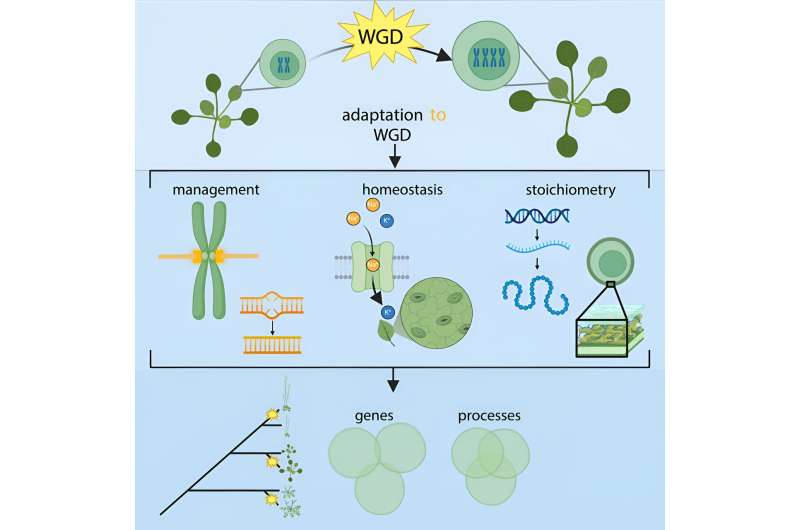This article has been reviewed according to Science X's editorial process and policies. Editors have highlighted the following attributes while ensuring the content's credibility:
fact-checked
peer-reviewed publication
trusted source
proofread
Surprising insight into cancer comes from unique plant species with different solutions to evolutionary challenges

A new study, led by experts at the University of Nottingham, has shown that different plant species tackle the same evolutionary hurdle in different ways, and the findings may give insight into aggressive forms of cancer.
Whole genome duplication (WGD) happens in all kingdoms of life. It is most common in plants, but also occurs in some of the most aggressive cancers. After WGD, the cell has extra genomes and is called polyploid.
Most of our major crops are also polyploid, including, wheat, apples, bananas, oats, strawberries, sugar and brassicas like broccoli and cauliflower. Polyploidy also occurs in some of the most aggressive gliomas (a brain cancer) and is associated with cancer progression. In general, polyploidy has been associated with robustness (as in crops) and adaptation to the environment (as in cancers that metastasize).
Because polyploids have more genomes to manage, the doubling of these genomes can be a weakness, so it is important to understand what factors stabilize young polyploids and how genome doubled–populations evolve.
In this new study, published in Cell Reports, experts from the University's School of Life Sciences look at how three successful polyploid plant species evolved to manage the extra DNA and whether they each did this differently or all the same way.
Professor Levi Yant, who led the study said, "Understanding the range of issues that face polyploids may help us to understand why some succeed while others don't. We see that successful polyploids overcome specific issues with DNA management and we focus on exactly what their 'natural solutions' are.
"In our study, we looked at three instances where species have adapted to 'polyploid life' and not only survived, but even thrived. Then we looked at whether they used the same molecular solutions to survive. Surprisingly, they did not."
The researchers found that the clearest signal of rapid adaptation to the polyploid state came from the CENP-E molecule, which is an exact molecule that other groups recently found to be an Achillies heel for polypoid cancers, and is a promising therapeutic target to kill the cancers. The next clearest signal came from "meiosis genes," which Professor Yant notes are turned on in many cancers, whereas they are turned off in nearly all normal cells.
"We discovered signals of rapid adaptation to the WGD state in the same molecular networks, and in the case of CENP-E, the exact molecule that is specifically important to polyploid cancers," continues Professor Yant.
"This WGD gives cancer a short-term advantage over most therapies, but targeting that exact molecule, CENP-E, specifically kills the polyploid cancer. This is a striking example of evolutionary repetition (or convergence) from completely different directions, but to the same adaptive hurdle. We can now take this model that adapts well to polyploidy and that can inform our thinking about certain types of cancer."
The findings of the study could impact our understanding of how certain polyploid cancers, such as gliomas (brain cancers) are able to use polyploidy to progress, and what molecules can be targeted as part of any therapy to "kill" the cancer cells.
More broadly, the study is important evidence that shows that mining evolutionary biology for these natural solutions can inform future therapies. Finally, the study also illustrates different ways that we can better engineer our many polyploid crops to be more resilient to certain cataclysmic events in the future—such as climate change.
More information: Sian M. Bray et al, Kinetochore and ionomic adaptation to whole-genome duplication in Cochlearia shows evolutionary convergence in three autopolyploids, Cell Reports (2024). DOI: 10.1016/j.celrep.2024.114576
Journal information: Cell Reports
Provided by University of Nottingham



















